Fertilizing potatoes before flowering or during budding has a positive effect on the taste and quantity of the crop. Based on a specific problem, it is necessary to determine the fertilizer strategy - one-time during the period of flower formation, another during the growing season, reusable immediately after planting, for the growth of tubers in the middle of the season and just before digging to control pests.
Content
The right approach to fertilizing
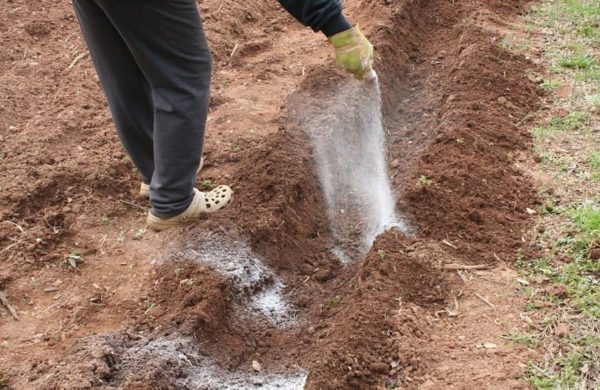
Potatoes are fed in accordance with the rules that ensure the effectiveness of the funds. Any fertilizer has a short-term effect. The plant quickly absorbs nutrients, so it is necessary to organize several dressings. This requires more fertilizer, and hence costs.
It is necessary to take into account the appearance of the plant. If the leaves of the tops turned yellow or acquired a purple hue, the flowers appeared and immediately withered; these are symptoms of a lack of vitamins. In this case, for a good harvest, additional feeding will definitely be needed.
Fertilizing potatoes with a standard set will not work. This vegetable crop has provisions for better development of the potato fruit. However, fertilizers are not the only means on which how quickly the crop grows:
- Before planting, potato tubers need to be warmed up well. Warm, revive after hibernation, they will bring the crop faster.
- Earth must also be warm. No means will save the crop if the soil is not sufficiently warmed up and is not able to give heat to tubers.
- Loosened soil. Planting a plant in hard and unheated soil is a mistake. Young shoots of potatoes after germination will not be able to break through dense soil and die. In loose soft soil there is a lot of oxygen and it is easier for the plant to grow.
- Hilling. The breaking of the stem, which occurs due to the severity of the tops, causes oxygen deprivation of young potatoes, the plant withers, and the crop dies with it.
- Timely insect control. Colorado potato beetle eating during the budding season is a serious problem. Timely disposal of harmful insects reduces the need for certain types of fertilizers. Herbicides and insecticides reduce the absorption of vitamins by insects and reduce the need for additional plant nutrition.
Fertilizing potatoes with mineral fertilizers must necessarily include the following elements:
- phosphorus;
- potassium;
- nitrogen;
- zinc;
- manganese;
- molybdenum;
- magnesium;
- boron.
It is optimal to combine all minerals and vitamins at once, but combining at least three of them will already have a better effect on the vegetable than using only one component. Feeding potatoes, a person takes care of his health: having accumulated enough vitamins and minerals, potatoes will give the best of them.
Types of Feeding
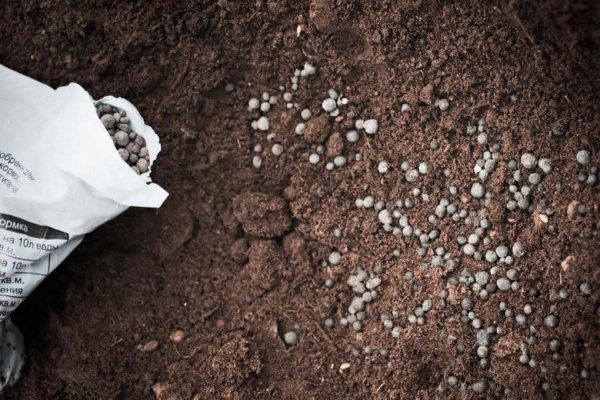
Two main types of top dressing: foliar and root. Feeding potatoes is better using both types. Foliar top dressing use when the growing season is already over. Then, by spraying the leaves and the stem, the vegetative system of the plant will not be damaged.
Another classification by season:
- Spring. Processing potatoes by leaf and root immediately after planting in the spring before flowering.
- Summer Potato top dressing in July. When the leaves are already formed, the potato blooms. Helps to get rid of harmful insects.
- Autumn. Top dressing a potato field. Increases yield next year.
By composition:
- Manganese. A manganese-rich supplement improves the taste of the product. It is better to feed the potatoes before hilling, during the growing season. Then the substance penetrates deeper and fills the void inside the potato cavity. The potato grows large, with a bright taste.
- Phosphorus. If potatoes were planted late, at the end of June or later, you need to use special fertilizer that stimulates rapid growth. With it, potatoes grow on time, the harvest is timely and tasty.
- Boron. The added boron top dressing of potatoes during the flowering period increases the volume of starch in the internal cavity of the potato. It turns out to be dense, solid and tasty.
Potato dressing in spring
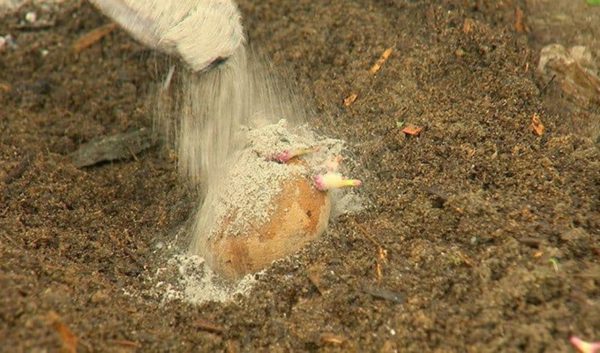
Fertilize potatoes after landing immediately necessary. Spring top dressing is one of the best investments in seedling care. There are two ways to feed potatoes after entrances: potash and organic fertilizers.
Mineral-containing potash fertilizers. A potato potash-loving plant. In the spring, for the best development, apply potassium directly under the root. To provide tubers with additional nutrition at an early stage of development, add potassium along with nitrogen. This provides better absorption of nutrients.
When hilling and planting, use chlorine-free fertilizer, otherwise it will affect the taste of potatoes. Highly concentrated fertilizers do not harm young tubers.
Nitroammofoska is a universal fertilizer that provides potatoes with a whole complex of useful substances. Although the potato is unpretentious in maintenance and does not need additional fertilizer, reinforcement to ensure uninterrupted growth does not harm.
In spring, phosphoric fertilizers should be applied even under winter tillage. This provides long-term nutrition of the soil, increases its yield quality for potatoes and other garden crops. Feed potatoes after germination will guarantee a good harvest.
Feeding potatoes during planting and after
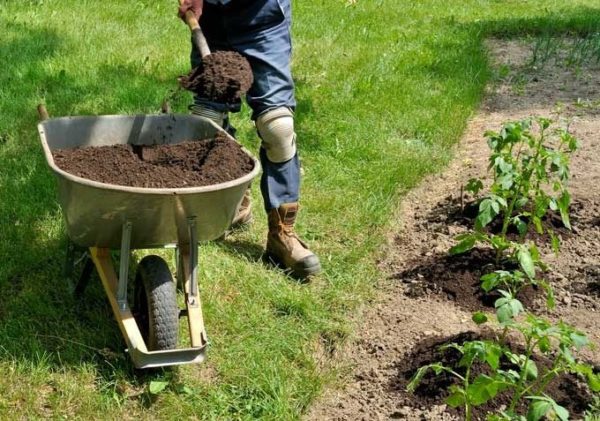 Top dressing during planting is most effective. Useful substances that are placed in the soil during planting, quickly get into a young plant and strengthen it. During planting, place fertilizer in each well with potatoes. In potatoes, the roots do not sprout very deep into the ground, but remain on the surface. Put organic fertilizer in the hole. At the same time, it is important that the manure is not completely fresh, in this case, under the influence of direct sunlight, it can begin to decompose and cause rotting of young tubers. The manure needs to be dried a little before putting in the hole.
Top dressing during planting is most effective. Useful substances that are placed in the soil during planting, quickly get into a young plant and strengthen it. During planting, place fertilizer in each well with potatoes. In potatoes, the roots do not sprout very deep into the ground, but remain on the surface. Put organic fertilizer in the hole. At the same time, it is important that the manure is not completely fresh, in this case, under the influence of direct sunlight, it can begin to decompose and cause rotting of young tubers. The manure needs to be dried a little before putting in the hole.
Ammonium nitrate should be added in the amount of 3 kg per hectare when nitroammophos is in the amount of 5 kg per hectare. For a square meter, spend 9 g of nitrate and 6 g of urea per square meter. The depth of the hole should be sufficient - up to 20 cm. Then, in the fall, the tubers will not come out ahead of time and will not turn green. Pour fertilizer to the very bottom of the hole, lay the planting tuber on top, and on top everything is sprinkled with earth.
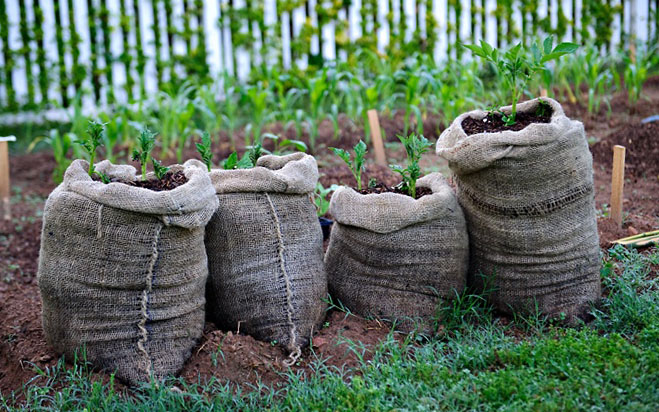 You may be interested in:
You may be interested in:After planting, you need to feed the potatoes before flowering to do this to ensure constant access of vitamins and minerals to newborn potato tubers. If at the post-planting stage apply foliar application of potatoes, it makes no sense.Elements will not be able to reach the root and tuberous system, so there is no need to use them. The best option for organizing feeding under the count:
- On a small landing site, select three plants, between them set a wooden stake. If the stake is removed, a hole is formed in its place.
- In this hole, pour a mixture of fertilizers from cattle manure and poultry manure.
- Half a kilogram of manure and 300 grams of chicken droppings diluted in 10 liters of water.
- Then pour the mixture into the recess.
- Scattering over the entire area, manure and litter lose their high concentration, therefore they do not harm the delicate root system of immature potatoes.
Fertilizing potatoes after germination will bear fruit.
Fertilizing flowering potatoes and fertilizing under the root
The next step is to feed the potatoes during flowering. At this point, phosphorus must be added. In 10 liters of water, 20 grams of potassium and 20 grams of double superphosphate are bred. Pour the mixture into the fertilizer well and leave to spread. Such dressing is best done a week after the formation of the first buds. Superphosphates counteract plant devouring by insects by Colorado potato beetles.
Top dressing a plant directly under the root is most effective:
- potatoes grow faster;
- tubers grow larger.
The best root fertilizer, determined by folk experts is ordinary dietary yeast. They contain:
- zinc;
- iron;
- magnesium.
Equally effective dry and raw yeast. They are bred in warm water. Sugar is added to activate living and beneficial bacteria. Insisting two to three hours, the yeast is applied directly under the root.
Root and foliar top dressing
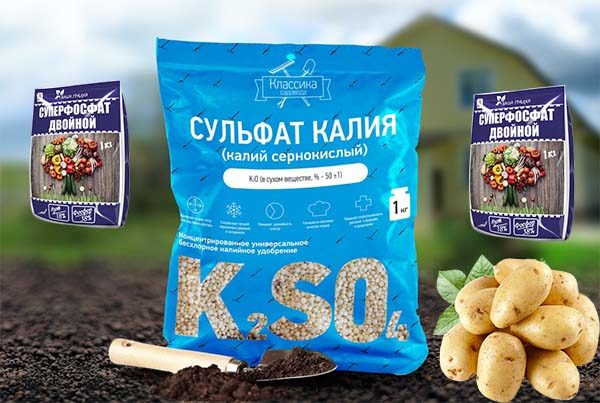
Foliar top dressing includes sheet processing. The effectiveness of foliar feeding is confirmed by the absence of the Colorado potato beetle and other insects on potatoes, the quality of the tops and the strength of the fruits. Dilute phosphorus, potassium and magnesium in water and apply to the foliage using a spray gun. Each element takes part in the formation of tops and then tubers. The dominant element is nitrogen. With its deficiency, potatoes will not be able to develop normally. Therefore, it can be bred and applied to foliage several times per season. It is safe and effective.
Foliar fertilizers also include biostimulants:
- antistressants;
- trace elements.
They act on the leaves, giving strength to the stem and roots.
Ways of applying dressing:
- Hole. At a short distance from three bushes, create a separate hole for fertilizers. As a result, they spread evenly and bring only benefits.
- Application under the root. In the watering can, part the food and pour under each bush.
- Hardwood treatment. To process leaves, but according to the vegetative system, food enters the root and tubers.
Cautions:
- Examination with the introduction of organic compounds of chicken and cow droppings causes rot and provokes an attack of insects.
- Excess nitrogen slows the formation of buds.
- Excessive watering when using fertilizers provokes a slowdown in growth and death.
Reviews
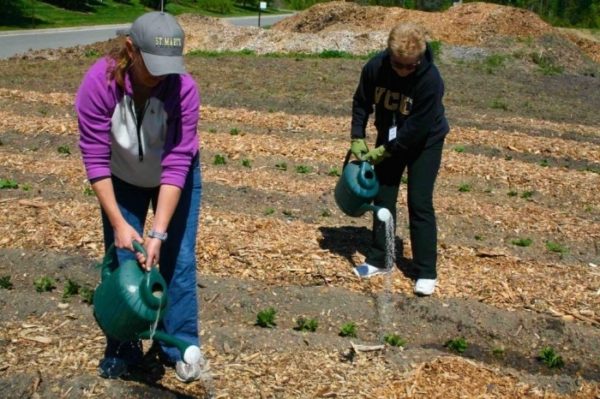
Studies show the importance of fertilizer in the spring at the planting and flowering stage: the amount of yield obtained is several times higher. And the reviews of gardeners confirm this.
Mira, 32 years old
All my life I thought that potatoes do not need to be fed growing and growing. But once I used nitrogen fertilizer and since then I have only grown potatoes. The harvest is timely, large and tasty.
Valentine, 42 years old
The fertilizer hole is the most effective potato remedy I've tried. Funds are spent more slowly, money is saved. It takes very little time to prepare such a fertilizer.
The decision on what exactly to feed potatoes is made depending on the problems that arise. An excess of additional funds is a threat, because it can provoke a number of problems. All top dressing for potatoes is safe for people.




 Description and description of varieties in Belarus with a photo
Description and description of varieties in Belarus with a photo Do I need to pick flowers from potatoes: why do they do it
Do I need to pick flowers from potatoes: why do they do it When to dig potatoes: timing and availability of new potatoes
When to dig potatoes: timing and availability of new potatoes How to grow a good potato crop: various methods and methods, planting and care
How to grow a good potato crop: various methods and methods, planting and care